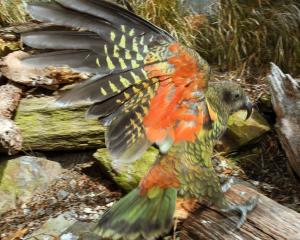The Department of Conservation is interviewing a man in connection with a fire that burnt more than 100ha of forest and tussock land high up in the Mt Aspiring National Park.
The fire in the East Matukituki Valley, near Hester Penney Creek, was reported to the Department of Conservation at 7.30pm on Monday.
Doc's conservation services manager in Wanaka, Chris Sydney, told the Otago Daily Times at 2pm yesterday the fire was ''contained and controlled'' and ground crews and three helicopters had been stood down.
One helicopter remained on site for fire-fighting purposes, and ''mopping up work'' would still need to be done over the next few days.
The fire's ''point of origin'' appeared to be on the East Matukituki track.
Mr Sydney said a helicopter made a sweep of the valley floor in search of trampers but found no-one. Late yesterday afternoon, a Doc spokesman confirmed a man was being interviewed.
Mr Sydney said conditions in the park were very dry which allowed the fire to move ''very rapidly''.
''The key message is for people in the back country to be extremely careful when conditions are as dry as they are.''
A fire investigator was already on the scene, looking into the cause, and Mr Sydney said the department was keen to speak to anyone who had witnessed the fire.
The fire was on steep, remote terrain at an altitude of about 800m-900m and at one point yesterday extended for 800m.
The left flank burnt through alpine tussock, known as turpentine shrub, and snow tussock, and the right flank burnt ''significant stands'' of beech forest.
''All the scrub and tussock will have been consumed and the fire has made it into the beech forest but it will be burning along the forest floor, not through the crown of the trees.
''And that's where a lot of our mop-up will happen - in underneath the beech trees.''
Big flames caused turbulence that made helicopter flying difficult, and Mr Sydney said the distance helicopter operators had to lift monsoon buckets, from the Matukituki River, was another difficulty.
Mr Sydney said it was the first fire in the park for at least eight or nine years.




